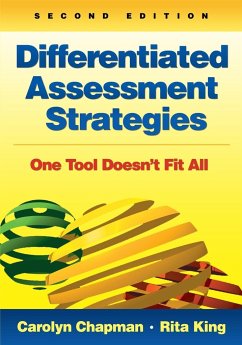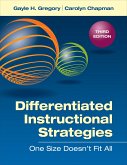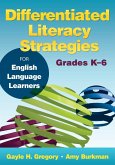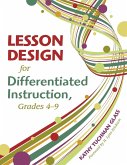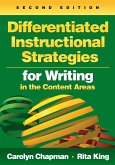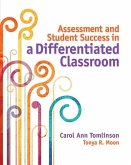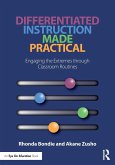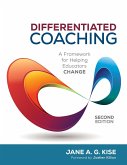- Broschiertes Buch
- Merkliste
- Auf die Merkliste
- Bewerten Bewerten
- Teilen
- Produkt teilen
- Produkterinnerung
- Produkterinnerung
This updated edition includes a generous selection of user-friendly strategies that help teachers assess struggling learners, students with special needs, children who are performing at grade level, and advanced learners. Included are practical tools that improve student performance and help them take responsibility for their own learning.
Andere Kunden interessierten sich auch für
![Differentiated Instructional Strategies Differentiated Instructional Strategies]() Gayle H. GregoryDifferentiated Instructional Strategies31,99 €
Gayle H. GregoryDifferentiated Instructional Strategies31,99 €![Differentiated Literacy Strategies for English Language Learners, Grades K-6 Differentiated Literacy Strategies for English Language Learners, Grades K-6]() Gayle H. GregoryDifferentiated Literacy Strategies for English Language Learners, Grades K-643,99 €
Gayle H. GregoryDifferentiated Literacy Strategies for English Language Learners, Grades K-643,99 €![Lesson Design for Differentiated Instruction, Grades 4-9 Lesson Design for Differentiated Instruction, Grades 4-9]() Kathy Tuchman GlassLesson Design for Differentiated Instruction, Grades 4-945,99 €
Kathy Tuchman GlassLesson Design for Differentiated Instruction, Grades 4-945,99 €![Differentiated Instructional Strategies for Writing in the Content Areas Differentiated Instructional Strategies for Writing in the Content Areas]() Carolyn ChapmanDifferentiated Instructional Strategies for Writing in the Content Areas40,99 €
Carolyn ChapmanDifferentiated Instructional Strategies for Writing in the Content Areas40,99 €![Assessment and Student Success in a Differentiated Classroom Assessment and Student Success in a Differentiated Classroom]() Carol Ann TomlinsonAssessment and Student Success in a Differentiated Classroom33,99 €
Carol Ann TomlinsonAssessment and Student Success in a Differentiated Classroom33,99 €![Differentiated Instruction Made Practical Differentiated Instruction Made Practical]() Rhonda BondieDifferentiated Instruction Made Practical46,99 €
Rhonda BondieDifferentiated Instruction Made Practical46,99 €![Differentiated Coaching Differentiated Coaching]() Jane A. G. KiseDifferentiated Coaching45,99 €
Jane A. G. KiseDifferentiated Coaching45,99 €-
-
-
This updated edition includes a generous selection of user-friendly strategies that help teachers assess struggling learners, students with special needs, children who are performing at grade level, and advanced learners. Included are practical tools that improve student performance and help them take responsibility for their own learning.
Hinweis: Dieser Artikel kann nur an eine deutsche Lieferadresse ausgeliefert werden.
Hinweis: Dieser Artikel kann nur an eine deutsche Lieferadresse ausgeliefert werden.
Produktdetails
- Produktdetails
- Verlag: SAGE Publications Inc
- 2 Revised edition
- Seitenzahl: 218
- Erscheinungstermin: 15. November 2011
- Englisch
- Abmessung: 254mm x 178mm x 12mm
- Gewicht: 422g
- ISBN-13: 9781412996648
- ISBN-10: 1412996643
- Artikelnr.: 33443503
- Herstellerkennzeichnung
- Libri GmbH
- Europaallee 1
- 36244 Bad Hersfeld
- gpsr@libri.de
- Verlag: SAGE Publications Inc
- 2 Revised edition
- Seitenzahl: 218
- Erscheinungstermin: 15. November 2011
- Englisch
- Abmessung: 254mm x 178mm x 12mm
- Gewicht: 422g
- ISBN-13: 9781412996648
- ISBN-10: 1412996643
- Artikelnr.: 33443503
- Herstellerkennzeichnung
- Libri GmbH
- Europaallee 1
- 36244 Bad Hersfeld
- gpsr@libri.de
Carolyn Chapman is an international educational consultant, author, and teacher who has taught in kindergarten to college classrooms. Her interactive, hands-on professional development training sessions challenge educators to use strategies that ensure success for learners of all ages. Chapman has written many books about differentiated instruction, multiple intelligences, multiple assessments, and the brain-compatible classroom. She is coauthor with Gayle Gregory of the landmark Corwin Press book Differentiated Instructional Strategies: One Size Doesn¿t Fit All.
Preface Acknowledgments About the Authors 1. One Tool Doesn
t Fit All: Introduction What Is Differentiated Assessment? Analyzing Your View of Differentiated Assessment Building the Toolbox to "Zap the Gaps" Assessment in the Age of Accountability What Is the Teacher
s Role in Differentiated Assessment? Opening the Toolbox 2. Bringing Research and Best Practices to Differentiated Formative Assessment Processing Information and Memory Why Students Forget and Why They Remember Assist the Brain in Memory Processing Develop Intelligent Behaviors for Assessment Authentic Assessment Performance Feedback 3. Creating a Climate for Formative Assessment The Affective Domain and Assessment Emotions Emotional Intelligence Self-Efficacy Motivation for Assessment The Physical Environment Setting Climate Goals 4. Knowing the Learner Information Gathering Gardner
s Multiple Intelligence Theory Exploring Goleman and Sternberg More Ways to View Learners Through Animals
Eyes Performance Level Titles for the Assessed Learner Summary 5. Exploring Self-Assessment What Is Self-Assessment? What Is Self-Talk? Self-Talk for Task Assessment Teaching Self-Assessment Why Is It Important to Teach Learners How to Self Assess? Self-Checking Techniques for Assessment Assess On-Task Behaviors Summary 6. Formative Assessment Before the Learning Personalize Instructional Planning Engaging Students Before the Learning Summary 7. Formative Assessment During the Learning Formative Assessment Tools to Use During the Learning Summary 8. Formative Assessment After the Learning Assessment Tools: After the Learning Bloom
s Taxonomy for Comprehension Assessment Summary 9. Differentiating Summative Assessments How Can Standardized Assessments Be Differentiated? Create a Positive Testing Environment Give Effective Directions Teach Test-Taking Skills Grading Summary 10. Assessment for Differentiated Instruction and Flexible Grouping Using Technology for Assessment Assessment Cubing Choice Boards Assessment Agendas Station, Centers, and Learning Zones for Assessment Assessment for Flexible Grouping Evaluating Group Work Group Discussion: Assessment Troubleshooting Tools for Group Assessment Summary 11. Differentiated Instructional Planning Models Adjustable Assignment Model Curriculum Compacting Model Academic Contract Model Project-Based Model Problem-Based Model Summary 12. Planning for Differentiated Assessment Step Up to Formative Assessment Planning Content, Process, Product, and Learning Disposition Assessment Essential Questions for Planning Assess the Assessment Tool Teaching Assessment Strategies Effective Differentiated Assessment Practices Generate Change for Differentiated Formative Assessment Summary Bibliography Index Summary
t Fit All: Introduction What Is Differentiated Assessment? Analyzing Your View of Differentiated Assessment Building the Toolbox to "Zap the Gaps" Assessment in the Age of Accountability What Is the Teacher
s Role in Differentiated Assessment? Opening the Toolbox 2. Bringing Research and Best Practices to Differentiated Formative Assessment Processing Information and Memory Why Students Forget and Why They Remember Assist the Brain in Memory Processing Develop Intelligent Behaviors for Assessment Authentic Assessment Performance Feedback 3. Creating a Climate for Formative Assessment The Affective Domain and Assessment Emotions Emotional Intelligence Self-Efficacy Motivation for Assessment The Physical Environment Setting Climate Goals 4. Knowing the Learner Information Gathering Gardner
s Multiple Intelligence Theory Exploring Goleman and Sternberg More Ways to View Learners Through Animals
Eyes Performance Level Titles for the Assessed Learner Summary 5. Exploring Self-Assessment What Is Self-Assessment? What Is Self-Talk? Self-Talk for Task Assessment Teaching Self-Assessment Why Is It Important to Teach Learners How to Self Assess? Self-Checking Techniques for Assessment Assess On-Task Behaviors Summary 6. Formative Assessment Before the Learning Personalize Instructional Planning Engaging Students Before the Learning Summary 7. Formative Assessment During the Learning Formative Assessment Tools to Use During the Learning Summary 8. Formative Assessment After the Learning Assessment Tools: After the Learning Bloom
s Taxonomy for Comprehension Assessment Summary 9. Differentiating Summative Assessments How Can Standardized Assessments Be Differentiated? Create a Positive Testing Environment Give Effective Directions Teach Test-Taking Skills Grading Summary 10. Assessment for Differentiated Instruction and Flexible Grouping Using Technology for Assessment Assessment Cubing Choice Boards Assessment Agendas Station, Centers, and Learning Zones for Assessment Assessment for Flexible Grouping Evaluating Group Work Group Discussion: Assessment Troubleshooting Tools for Group Assessment Summary 11. Differentiated Instructional Planning Models Adjustable Assignment Model Curriculum Compacting Model Academic Contract Model Project-Based Model Problem-Based Model Summary 12. Planning for Differentiated Assessment Step Up to Formative Assessment Planning Content, Process, Product, and Learning Disposition Assessment Essential Questions for Planning Assess the Assessment Tool Teaching Assessment Strategies Effective Differentiated Assessment Practices Generate Change for Differentiated Formative Assessment Summary Bibliography Index Summary
Preface Acknowledgments About the Authors 1. One Tool Doesn
t Fit All: Introduction What Is Differentiated Assessment? Analyzing Your View of Differentiated Assessment Building the Toolbox to "Zap the Gaps" Assessment in the Age of Accountability What Is the Teacher
s Role in Differentiated Assessment? Opening the Toolbox 2. Bringing Research and Best Practices to Differentiated Formative Assessment Processing Information and Memory Why Students Forget and Why They Remember Assist the Brain in Memory Processing Develop Intelligent Behaviors for Assessment Authentic Assessment Performance Feedback 3. Creating a Climate for Formative Assessment The Affective Domain and Assessment Emotions Emotional Intelligence Self-Efficacy Motivation for Assessment The Physical Environment Setting Climate Goals 4. Knowing the Learner Information Gathering Gardner
s Multiple Intelligence Theory Exploring Goleman and Sternberg More Ways to View Learners Through Animals
Eyes Performance Level Titles for the Assessed Learner Summary 5. Exploring Self-Assessment What Is Self-Assessment? What Is Self-Talk? Self-Talk for Task Assessment Teaching Self-Assessment Why Is It Important to Teach Learners How to Self Assess? Self-Checking Techniques for Assessment Assess On-Task Behaviors Summary 6. Formative Assessment Before the Learning Personalize Instructional Planning Engaging Students Before the Learning Summary 7. Formative Assessment During the Learning Formative Assessment Tools to Use During the Learning Summary 8. Formative Assessment After the Learning Assessment Tools: After the Learning Bloom
s Taxonomy for Comprehension Assessment Summary 9. Differentiating Summative Assessments How Can Standardized Assessments Be Differentiated? Create a Positive Testing Environment Give Effective Directions Teach Test-Taking Skills Grading Summary 10. Assessment for Differentiated Instruction and Flexible Grouping Using Technology for Assessment Assessment Cubing Choice Boards Assessment Agendas Station, Centers, and Learning Zones for Assessment Assessment for Flexible Grouping Evaluating Group Work Group Discussion: Assessment Troubleshooting Tools for Group Assessment Summary 11. Differentiated Instructional Planning Models Adjustable Assignment Model Curriculum Compacting Model Academic Contract Model Project-Based Model Problem-Based Model Summary 12. Planning for Differentiated Assessment Step Up to Formative Assessment Planning Content, Process, Product, and Learning Disposition Assessment Essential Questions for Planning Assess the Assessment Tool Teaching Assessment Strategies Effective Differentiated Assessment Practices Generate Change for Differentiated Formative Assessment Summary Bibliography Index Summary
t Fit All: Introduction What Is Differentiated Assessment? Analyzing Your View of Differentiated Assessment Building the Toolbox to "Zap the Gaps" Assessment in the Age of Accountability What Is the Teacher
s Role in Differentiated Assessment? Opening the Toolbox 2. Bringing Research and Best Practices to Differentiated Formative Assessment Processing Information and Memory Why Students Forget and Why They Remember Assist the Brain in Memory Processing Develop Intelligent Behaviors for Assessment Authentic Assessment Performance Feedback 3. Creating a Climate for Formative Assessment The Affective Domain and Assessment Emotions Emotional Intelligence Self-Efficacy Motivation for Assessment The Physical Environment Setting Climate Goals 4. Knowing the Learner Information Gathering Gardner
s Multiple Intelligence Theory Exploring Goleman and Sternberg More Ways to View Learners Through Animals
Eyes Performance Level Titles for the Assessed Learner Summary 5. Exploring Self-Assessment What Is Self-Assessment? What Is Self-Talk? Self-Talk for Task Assessment Teaching Self-Assessment Why Is It Important to Teach Learners How to Self Assess? Self-Checking Techniques for Assessment Assess On-Task Behaviors Summary 6. Formative Assessment Before the Learning Personalize Instructional Planning Engaging Students Before the Learning Summary 7. Formative Assessment During the Learning Formative Assessment Tools to Use During the Learning Summary 8. Formative Assessment After the Learning Assessment Tools: After the Learning Bloom
s Taxonomy for Comprehension Assessment Summary 9. Differentiating Summative Assessments How Can Standardized Assessments Be Differentiated? Create a Positive Testing Environment Give Effective Directions Teach Test-Taking Skills Grading Summary 10. Assessment for Differentiated Instruction and Flexible Grouping Using Technology for Assessment Assessment Cubing Choice Boards Assessment Agendas Station, Centers, and Learning Zones for Assessment Assessment for Flexible Grouping Evaluating Group Work Group Discussion: Assessment Troubleshooting Tools for Group Assessment Summary 11. Differentiated Instructional Planning Models Adjustable Assignment Model Curriculum Compacting Model Academic Contract Model Project-Based Model Problem-Based Model Summary 12. Planning for Differentiated Assessment Step Up to Formative Assessment Planning Content, Process, Product, and Learning Disposition Assessment Essential Questions for Planning Assess the Assessment Tool Teaching Assessment Strategies Effective Differentiated Assessment Practices Generate Change for Differentiated Formative Assessment Summary Bibliography Index Summary

